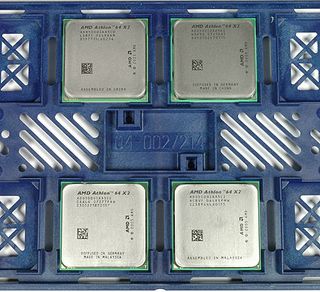AMD's Athlon Stepping Improvements
Step By Step: AMD's Athlon 64 X2 Progress Analyzed

The world is holding its breath as AMD readies the launch of its redone Phenom processors. As most tech-savvy users know, AMD has gotten off to a really bad start with the Phenom 9000 processors and their Opteron counterparts for the professional market. The quad core called Agena was supposed to get AMD back in the fast lane, after the firm was unable to offer a device that could keep up with Intel's Core 2 Duo. Unfortunately, the new product was not only many months late, but a nasty bug forced AMD to suspend shipments until a new revision of the micro chip would finally be available. Such a revision is referred to as a stepping, and it is imminent for the Phenom family. But what is the potential impact of such a new stepping? We looked at four different steppings of the Athlon 64 X2 5000 to look at the improvements. (Compare Prices on AMD Processors)
AMD already said that people should not expect major performance improvements when the new B3 stepping hits the market, as it is mainly a bug-fix release. The Phenom design consists of the typical 64+64 kB data and instruction L1 cache and 512 kB L2 cache per core plus a shared 2 MB L3 cache that is dynamically allocated to one or all cores. None of this will be changed and the instruction set and power management remain unchanged as well. This also applies for the manufacturing process; although AMD is on its way to producing 45-nm silicon later this year, Phenom remains tied to the 65-nm DSL SOI process (dual stress liner, silicon on insulator). Still, we believe that at least some clock speed improvements will be possible, as AMD has already handed out a few samples of a 2.4 GHz Phenom processor, which hasn't been commercially available yet.
AMD's progress is nicely summarized on its corporate Website at Desktop CPU Selector. Here you can select a processor family, model number, frequency, cache size, socket and other parameters to see if there are models specifically matching your requirements. We used this tool to find a processor model based on the dual-core Athlon 64 X2, which has been available long enough to have undergone multiple revisions. The processor of our choice was an Athlon 64 X2 5000, which we obtained in two 90-nm stepping versions and two more revisions based on the 65-nm process. Let's find out about the impact of the individual steppings.
Join our discussion on this article!
Stay On the Cutting Edge: Get the Tom's Hardware Newsletter
Get Tom's Hardware's best news and in-depth reviews, straight to your inbox.
Current page: Step By Step: AMD's Athlon 64 X2 Progress Analyzed
Next Page What's A Stepping?Most Popular

